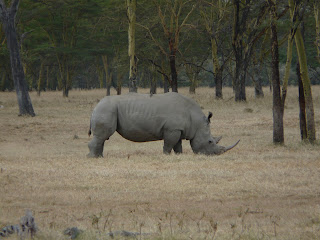The Big Five refers to the five most difficult animals to hunt on foot - they were not chosen based on size. The Big Five are the most dangerous mammals. They are the "must-sees" in Africa and thanks to our family's talent for game-spotting, we saw them all. We also saw a bunch of other animals that were pretty amazing. So, I've added five animals to the Big Five, making them the Big Ten - the ten most wonderful animals that we saw in Kenya.
1. Lion
We didn't get a chance to see a lion until our trip to Masai Mara, the last stop before heading back to Nairobi. Once we got to the Masai Mara, we saw lions four different times. We saw this beautiful lioness first, basking in the sun with three others. They weren't bothered at all about the safari vehicles lining up for pictures a few feet away. Other lion spottings included two males travelling together, a mother with a 2 day old cub, and a lioness eating her prey.

2. Leopard
The leopard is a difficult animal to spot, as it likes to stay hidden. Mike spotted this guy on our Treetops game drive from a far distance. We saw another one later on, hanging out by the river.

3. African Elephant
Our family has seen plenty of Asian elephants, but this was our first experience with African elephants. The African elephant is definitely larger than the Asian elephant and we saw massive herds of elephants, as well as smaller families travelling together. They were extremely protective over their babies, keeping them well hidden.

4. Cape Buffalo
The Cape Buffalo was a pretty common sightingon our trip. Like the elephants, they tend to travel in large herds. We watched a herd of them come to the watering hole from our bedroom window at Treetops. The buffalo is probably the most dangerous of African animals, causing the most hunter deaths. Otete explained that most animals have a way of communicating to humans and other animals that they are planning on attacking. The buffalo, however, does not. It attacks unprovoked and without warning.

5. Black Rhinoceros
The Black Rhinoceros is not named after its color. It is actually named the Black Rhino to distinguish it from the White Rhino, which was named because of the width of its mouth. Somewhere along the way, the Afrikaans word for width translated to white. Both the Black Rhino and the White Rhino are grayish in color and have two horns. The difference between them is the width of their mouth. The Black Rhino is very nearly extinct, due to the popularity of the rhino horn for Chinese medicine and Middle Eastern dagger handles. In thirty years, the Black Rhino population decreased from 20,000 to 400. They are now protected in fenced in reserves, so their numbers have slowly climbed up to 500.
 6. Giraffe
6. GiraffeI think the whole family would agree that the giraffe should be included as it is an incredibly majestic animal. We saw a lot of giraffes along our trip - the most beautiful was the Reticulated Giraffe, found in the Samburu National Reserve.  We all took tons of pictures of giraffes along the way and even though this one isn't of Reticulated Giraffes, it's my favorite. Otete informed us that the darker the giraffe is, the older it is. This old guy and baby were beautiful.
We all took tons of pictures of giraffes along the way and even though this one isn't of Reticulated Giraffes, it's my favorite. Otete informed us that the darker the giraffe is, the older it is. This old guy and baby were beautiful. 
7. Cheetah
 We all took tons of pictures of giraffes along the way and even though this one isn't of Reticulated Giraffes, it's my favorite. Otete informed us that the darker the giraffe is, the older it is. This old guy and baby were beautiful.
We all took tons of pictures of giraffes along the way and even though this one isn't of Reticulated Giraffes, it's my favorite. Otete informed us that the darker the giraffe is, the older it is. This old guy and baby were beautiful. 
7. Cheetah
One of the most remarkable things we saw in Kenya was this cheetah. On our first morning game drive, Otete started getting radio chatter about something exciting. We arrived to find this cheetah stalking a gazelle. Otete moved our van closer to the gazelle, so we got to see the cheetah take off at full speed after it. He didn't catch the gazelle, so he walked back past us. It was mind-blowing!

8. Baboon
This one is Otete's favorite. When asked what he most likes to see on game drives, he replied "I love to see a family of baboons frolicking and playing together." They were pretty fun to watch.




9. Warthog
One of Mum's favorites was the warthog. Pat got pretty close to one when we stopped to look out over a beautiful view. I loved Pumbaa's wispy hairs and adorable little run.

10. Gerenuk
This beautiful herbivore is also called the "Giraffe-necked Antelope". The men have horns and the females do not. They tend to eat in higher to reach places than other antelopes by standing on their hind legs. Interesting fact: these animals do not need to drink - they get enough water from the plants that they eat.

This is by no means an exhaustive list of the marvelous animals we saw in Kenya. I'm sure I'm forgetting a few must-sees, but I guess this is a good start. More to come!
2 comments:
The warthog and the giraffes are my favorite!!!
SO COOL! What a fun trip and so many amazing animals :)
Post a Comment